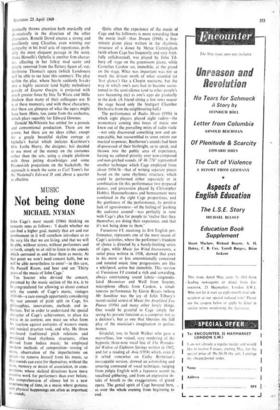Not being done
MUSIC
MICHAEL NYMAN
John Cage's most recent (1966) thinking on concerts runs as follows: 'I doubt whether we can find a higher goal, namely that art and our involvement in it will somehow introduce us to .
the very-life that we are living, and that we will be able, without scores, without performers and so forth, simply to sit still to listen to the sounds which surround us and hear them as music. At that point we won't need concert halls, but we will be able nevertheless to enter'—in this case, the Purcell Room, and hear and see 'Thirty • years of the music of John Cage.'
Tim Souster who devised the concert, presented by the music section of the ICA, is to be congratulated for allowing us direct contact with the sounds of Cage's music, vvintages 1938-66—a rare enough opportunity considering the vast amount of print spilt on Cage, his philosophies, innovations, methods and in- fluences. Yet in order to understand the special character of Cage's achievement, to place his music in its context, one must see what form his reaction against centuries of western music and musical practice took, and why. He threw overboard traditional pitch relations and employed fixed rhythmic structures, often derived from Indian music; he employed random methods of composition—tossing of coins, observation of the imperfections on Paper—to remove himself from his music, so that sounds can exist for themselves, without the taste, memory or desire of association, in com- positions whose skeletal directions leave more creative work for performers than ever before. His comprehension of silence led to- a new exPeriencing of time; in a music where gestures and physical happenings are often as important as sounds,
Quite often the experience of the music of Cage and his followers is more rewarding than the music- itself—thus Dream (1948), a five- minute piano piece written in the rhythmic structure of a dance by Merce Cunningham (with whom Cage has frequently and very fruit- fully collaborated), was played by John Til- bury off stage on the greenroom piano, while Cornelius Cardew sat, immobile, at the grand on the stage. What was important was not so much the distant swirls of what sounded (at 'first glance') like a Chopin nocturne, but the way in which one's ears had to become accus- tomed to the semi-silence (and to other people's ears becoming etc) as one's eyes do gradually to the dark. (A friend sitting a few rows nearer the stage heard only the Stuttgart Chamber Orchestra from the neighbouring hall.) The performance of Radio Music (1956) in which eight players played eight radios—the momentary coming into focus of music one knew out of the prevailing mists of radio static —not only discovered something new and un- repeatable, but reassembled to some extent our musical responses. Beethoven's sounds had been dispossessed of their birthright, so to speak, and thrown into the public area of experience, having no cultural priority over non-composed and non-pitched sounds. 34' 46.776" represented another technique which Cage employed from about 1954-56—that of writing separate pieces based on the same rhythmic structure, which could be performed either separately or in combination (in this performance two prepared' pianos, and percussion played by Christopher Hobbs). Humourlessness and bemusement were combined in the right Cage proportions, and the gentleness of the performance, its positive lack of agressiveness—of the feeling of 'pushing the audience around'—was perfectly in tune with Cage's plea for people to 'realise that they themselves are doing their experience, and that it's not being done to them.'
Variations VI, receiving its first English per- formance, represents one of the most recent of Cage's activities, where the performer's freedom of choice is directed by a barely-limiting series of signs, while Music for Wind Instruments, a serial piece written in 1938, showed that even in his more or less conventionally conceived and notated music time progressions are like a whirlpool, active but immobile. This version of Variations VI created a rich and rewarding, always entertaining sound fabric—ringmodu- lated Moonriver and Weill from Souster, microphone effects from Cardew, a simul- taneous performance by Gavin Bryars (whose Mr Sunshine was the joy of John Tilbury's recent recital series) of Music for Amplified Toy Pianos (1956) and many other lovely things. One would be grateful to Cage simply for seeing his present function as a composer not as a dictator's, but as one that liberates the full play of the musician's imagination in perfor- mance.
Grateful, too, to Sarah Walker who gave a marvellous, low voiced, sexy rendering of .th3 hypnotic three-note vocal line of The Wonder- ful Widow of Eighteen Springs written in 1942, and for a reading of Aria (1958) which, even if it relied somewhat on Cathy Berberian's inescapable version, showed an astonishing and amusing command of vocal technique, ranging from pidgin English with a Japanese accent to. vocalised gibbering, and from an expressive in- take of breath to the exaggerations of grand opera. The genial spirit of Cage hovered here, as over the whole evening from beginning to end.










































 Previous page
Previous page